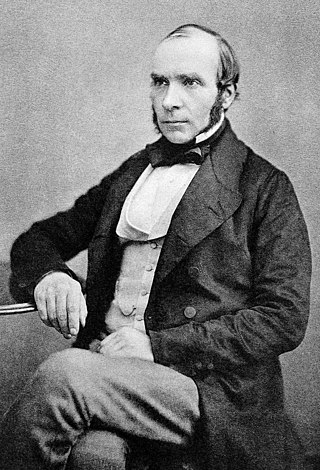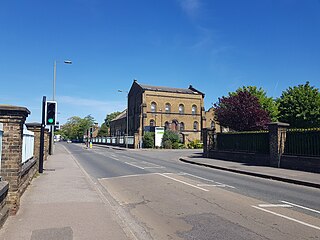Related Research Articles

Hampton is a suburban area on the north bank of the River Thames, in the London Borough of Richmond upon Thames, England, and historically in the County of Middlesex. which includes Hampton Court Palace. Hampton is served by three railway stations, including one immediately south of Hampton Court Bridge in East Molesey.

Sir Joseph William Bazalgette CB was a 19th-century English civil engineer. As chief engineer of London's Metropolitan Board of Works, his major achievement was the creation of a sewerage system for central London which was instrumental in relieving the city of cholera epidemics, while beginning to clean the River Thames. He was also the designer of Hammersmith Bridge.

John Snow was an English physician and a leader in the development of anaesthesia and medical hygiene. He is considered one of the founders of modern epidemiology, in part because of his work in tracing the source of a cholera outbreak in Soho, London, in 1854, which he curtailed by removing the handle of a water pump. Snow's findings inspired the adoption of anaesthesia as well as fundamental changes in the water and waste systems of London, which led to similar changes in other cities, and a significant improvement in general public health around the world.

Slow sand filters are used in water purification for treating raw water to produce a potable product. They are typically 1–2 m (3.3–6.6 ft) deep, can be rectangular or cylindrical in cross section and are used primarily to treat surface water. The length and breadth of the tanks are determined by the flow rate desired by the filters, which typically have a loading rate of 200–400 litres (0.20–0.40 m3) per square metre per hour.

Seething Wells is a neighbourhood in southwest London on the border between Surbiton in the Royal Borough of Kingston upon Thames in Greater London, and Elmbridge in Surrey. The area was historically a waterworks that supplied London with water from the River Thames. Nowadays it is mainly a residential area, with the notable exception of decommissioned filter beds — the Seething Wells Filter Beds — in the northwest part of the area that borders the Thames.

The Metropolitan Water Board was a municipal body formed in 1903 to manage the water supply in London, UK. The members of the board were nominated by the local authorities within its area of supply. In 1904 it took over the water supply functions from the eight private water companies which had previously supplied water to residents of London. The board oversaw a significant expansion of London's water supply infrastructure, building several new reservoirs and water treatment works.

Molesey Lock is a lock on the River Thames in England at East Molesey, Surrey on the right bank.

The Staines Reservoirs are two large pumped storage reservoirs sitting to the east of the King George VI Reservoir near Heathrow airport in Surrey within the Colne Valley regional park. The village of Stanwell is mainly to the north east, and the town of Staines is to the south.

The Knight Reservoir is a large pumped storage reservoir located in the Borough of Elmbridge in Surrey. It was inaugurated in 1907 and stores up to 2,180 million litres of raw water abstracted from the River Thames prior to its treatment and supply to London and north Surrey. It is located south of the River Thames, west of West Molesey, and between Hurst Road (A3050) and Walton Road (B369). It is adjacent to, and west of, its twin Bessborough Reservoir.

London's water supply infrastructure has developed over the centuries in line with the expansion of London.

The Chelsea Waterworks Company was a London waterworks company founded in 1723 which supplied water to many central London locations throughout the 18th and 19th centuries until its functions were taken over by the Metropolitan Water Board in 1904.
The East London Waterworks Company was one of eight private water companies in London absorbed by the Metropolitan Water Board in 1904.
Joseph Quick was an English civil engineer who was closely involved in improvements to supply piped water in the great industrial cities of the nineteenth century. Both his father and his son were also waterworks engineers by the name Joseph Quick.
The Southwark and Vauxhall Waterworks Company was a utility company supplying water to parts of south London in England. The company was formed by the merger of the Southwark and Vauxhall water companies in 1845 and became part of the publicly owned Metropolitan Water Board in 1904.

The Broad Street cholera outbreak was a severe outbreak of cholera that occurred in 1854 near Broad Street in Soho, London, England, and occurred during the 1846–1860 cholera pandemic happening worldwide. This outbreak, which killed 616 people, is best known for the physician John Snow's study of its causes and his hypothesis that germ-contaminated water was the source of cholera, rather than particles in the air. This discovery came to influence public health and the construction of improved sanitation facilities beginning in the mid-19th century. Later, the term "focus of infection" started to be used to describe sites, such as the Broad Street pump, in which conditions are favourable for transmission of an infection. Snow's endeavour to find the cause of the transmission of cholera caused him to unknowingly create a double-blind experiment.
The Grand Junction Waterworks Company was a utility company supplying water to parts of west London in England. The company was formed as an offshoot of the Grand Junction Canal Company in 1811 and became part of the publicly owned Metropolitan Water Board in 1904.
The Lambeth Waterworks Company was a utility company supplying water to parts of south London in England. The company was established in 1785 with works in north Lambeth and became part of the publicly owned Metropolitan Water Board in 1904.
The Metropolitan Turnpike Trust was the body responsible for maintaining the main roads in the north of the conurbation of London from 1827 to 1872. The commissioners took over from fourteen existing turnpike trusts, and were empowered to levy tolls to meet the costs of road maintenance.
The history of water filters can be traced to the earliest civilisations with written records. Water filters have been used throughout history to improve the safety and aesthetics of water intended to be used for drinking or bathing. In modern times, they are also widely used in industry and commerce. The history of water filtration is closely linked with the broader history of improvements in public health.

The Metropolis Water Act 1852 was an Act of the Parliament of the United Kingdom which introduced regulation of water supply companies in London, including minimum standards of water quality for the first time.
References
- ↑ "BRIEF HISTORY DURING THE SNOW ERA – UCLA Department of Epidemiology West Middlesex Waterworks history". ph.ucla.edu. Retrieved 3 June 2015.
- ↑ Roberts, G. (2006). Chelsea to Cairo-- 'Taylor-made' Water Through Eleven Reigns and in Six Continents: A History of John Taylor & Sons and Their Predecessors. Thomas Telford. ISBN 9780727734112 . Retrieved 3 June 2015.
- ↑ "John Snow On the Mode of Communication of Cholera (Pamphlet) 1849, 1850" (PDF). matrix.msu.edu. Retrieved 3 June 2015.
- ↑ An Act to make better Provision respecting the Supply of Water to the Metropolis, (15 & 16 Vict. c .84)